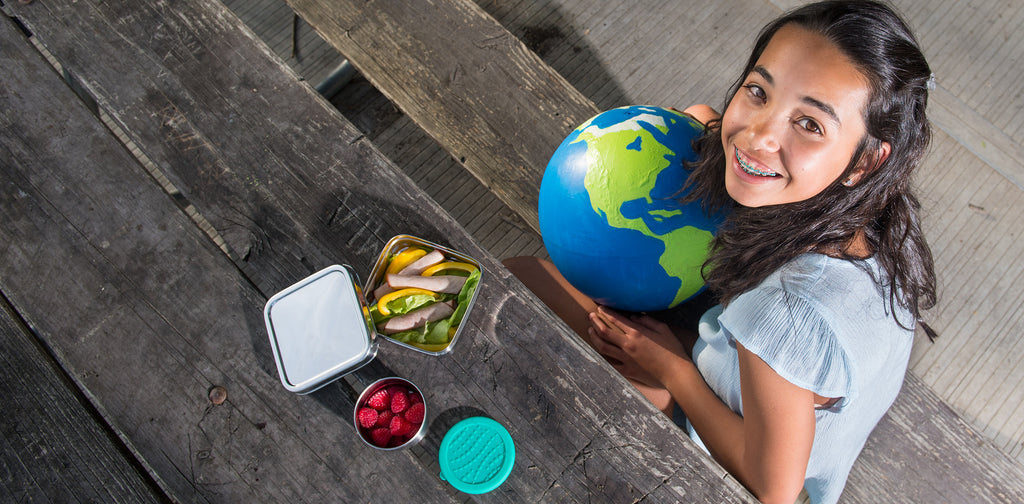Our Planet Impact

Plastic pollutes and contributes to global warming
ECOlunchbox’s mission is to help people reduce their use and disposal of plastic by providing non-toxic, plastic-free lunch boxes that are healthy for people and the planet.
The use and disposal of plastic contributes to pollution in many ways. Most well understood is the tragedy of plastic getting lost or dumped in the environment and accumulating in our oceans. Less understood but equally as damaging to our planet is how plastic contributes to global warming.
As a mission-based company founded in 2008 to help people say goodbye to plastic, ECOlunchbox has been keenly focused since our inception on making a difference in every way possible. By dedicating ourselves to educating, inspiring and empowering people to adopt a plastic-free lifestyle we have endeavored to be a positive force within the ongoing movement to combat plastic pollution.

How we calculated our positive impact
Our impact is very important to us, so we measure it. With the help of a team of MBA students from the Presidio Graduate School in San Francisco, we started many years ago annually quantifying our positive impact when it comes to averting pollution as well as minimizing climate change. We use a nationally recognized waste reduction model to calculate how much trash and plastic are averted from the use of our products and then convert this into tons of carbon offset.

We think you’ll be amazed to learn just how much of an impact one small green company and its dedicated community of plastic-free ECOlunchbox users can have on the environment. We've sold more than 914,581 plastic-free lunch boxes made from steel and silicone.
The graduate students approached their ECOlunchbox impact analysis by adding up the waste diverted through the use of our reusable food containers. They entered the information into a carbon footprint tool called the Waste Reduction Model (WARM) developed by the U.S. Environmental Protection Agency (U.S. EPA). Our analysis determined that the use of ECOlunchboxes in lieu of plastic baggies, single-use napkins and utensils, pre-packaged snacks and other throwaways discussed in our ECOlunchbox Litterless Lunch Study, has averted 60 million pounds of waste from being created and disposed of, according to our estimated calculations based on typical lunch waste.
Learn how plastic contributes to global warming

In addition to polluting our oceans and burdening our landfills, plastic contributes negatively to air pollution and global warming. More than 99% of plastic is made from fossil fuels, like ethane that is a byproduct of the fracking of natural gas. At every stage in its lifestyle, from its extraction, transport, manufacturing into pellets, use in products and eventual disposal, plastic intensively emits carbon dioxide into the atmosphere.
While consumers may think their plastic can be recycled, data shows that only about 5% of plastic is recycled. It’s much more likely that disposed plastic is buried or burned due to inadequate plastic recycling system. When incinerated, plastic releases toxic carbon dioxide. Across its lifecycle, plastic pollution disproportionately harms people of color and low-income communities who live near extraction, processing and incineration facilities.
Carbon dioxide equivalents in everyday terms

The next step was to use the model to convert the weight of the trash averted into a greenhouse gas equivalent. We then determined that ECOlunchbox's annual greenhouse gas aversion is 9,417 metric tons of CO2e (carbon dioxide equivalent)! To understand what it means in layman’s terms, the next step was to convert this abstract number into everyday offset examples.
We used the U.S. EPA’s greenhouse gas equivalencies calculator to frame our positive impact on global warming in ways we can understand. The use of ECOlunchbox’s products results in the equivalent of averting the greenhouse gas emissions from 24 million miles driven by passenger vehicles in one year. Want to think about our planet impact another way? The calculator also shows that annually we’re averting the CO2 emissions from 10.5 million pounds of coal burned, the carbon sequestered by 155,711 tree seedlings grown for 10 years, 1,187 homes’ electricity use for one year, or more than 1 billion smart phones charged.
Learn how to calculate your own carbon footprint

We all impact the planet in the decisions we make day to day - from how we pack our lunch to how many miles we drive and how many lights we turn on at home. The impact you make by releasing CO2 is called your carbon footprint.
If you’d like to calculate your own carbon footprint, try using a simple online tool that can estimate your carbon dioxide usage based on your income, family size and geographic location. For more in-depth analysis, the U.S. EPA offers another online carbon footprint analysis tool for individuals.

To put it in everyday terms what the resulting carbon dioxide usage means, input your personal CO2 estimate into an equivalency calculator.
Reducing waste at lunchtime (and beyond!) is one of many eco-friendly strategies that help reduce your environmental footprint. If you’re interested in learning more about the environmental and financial benefits of reducing trash at lunchtime, check out our Lunch Study.
Thank you to our ECOlunchbox community for buying and using our products. Together we are making a change at lunchtime!

